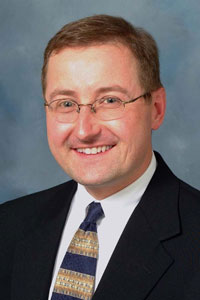 |
Chis Kratochvil, M.D. |
The findings of the Treatment for Adolescents with Depression Study (TADS), which was led by Duke University psychiatrist John March, M.D., were published in the October issue of the Archives of General Psychiatry.
The multicenter study indicated that a combination therapy improved depressive symptoms and reduced the level of suicidal thinking and behavior in adolescents. About 20 percent of the patients enrolled in the study were from UNMC, the largest percentage of the participating institutions.
“The study is significant in that it is the first to compare the acute effectiveness of cognitive behavioral therapy and medication, individually and in combination, in depressed adolescents,” said Dr. Kratochvil, an associate professor in the UNMC Department of Psychiatry. “We know that depression among teenagers is a significant public health problem, and the recent TADS findings will assist clinicians by demonstrating that the benefits of treatment with medication, combined with cognitive behavior therapy, outweigh the risks.”
Funded by the National Institute of Mental Health, a division of the National Institutes of Health, TADS is a randomized clinical trial examining the individual and combined effectiveness of the antidepressant Prozac and cognitive behavioral therapy in adolescents diagnosed with depression.
The study, which included 327 patients between the ages of 12 and 17 with a primary diagnosis of major depressive disorder, showed that combination therapy was more effective than medication alone over the course of 36 weeks.
At week 12 of the study, depression decreased among all treatment groups but the group receiving combination therapy had the greatest reduction with a 71 percent response rate.
At 18 weeks, the combination treatment continued to demonstrate superiority to either treatment alone with an 85 percent response rate, compared to 69 percent for patients taking only Prozac and 65 percent for patients only participating in CBT.
At the conclusion of 36 weeks, combination treatment had the highest response rate at 86 percent compared to 81 percent each for each of the other groups.
Although participants commonly reported suicidal thoughts at the study’s inception, researchers found that patients in all treatment groups had decreased levels of such thoughts, while the teens treated with Prozac alone had a higher rate of both suicidal thinking and behaviors than those treated with combination therapy or CBT only.
These findings point to the potential benefits of a two-pronged approach — Prozac for recovery from depressive symptoms and cognitive behavioral therapy to equip adolescents with coping skills.
“While many questions still remain about the safest and most beneficial course of treatment for adolescents, this data provides a significant step forward,” Dr. March said. “It provides an evidence-based option that has been found to improve depression through medication used together with cognitive-behavioral psychotherapy.”